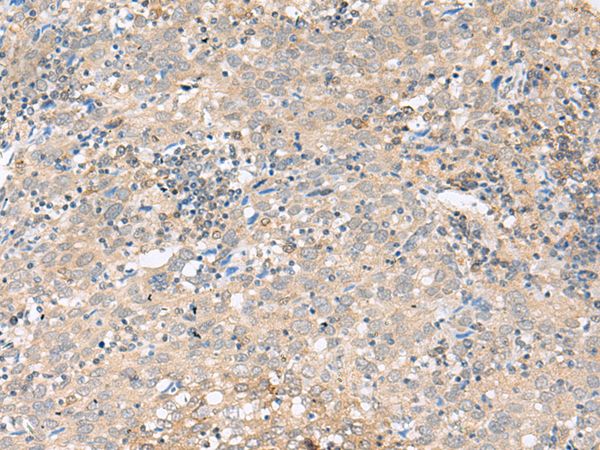
| WB | 咨询技术 | Human,Mouse,Rat |
| IF | 咨询技术 | Human,Mouse,Rat |
| IHC | 1/40-1/200 | Human,Mouse,Rat |
| ICC | 技术咨询 | Human,Mouse,Rat |
| FCM | 咨询技术 | Human,Mouse,Rat |
| Elisa | 1/5000-1/10000 | Human,Mouse,Rat |
| Aliases | DA3; DA5; MWKS; DAIPT; FAM38B; HsT748; HsT771; FAM38B2; C18orf30; C18orf58 |
| Host/Isotype | Rabbit IgG |
| Antibody Type | Primary antibody |
| Storage | Store at 4°C short term. Aliquot and store at -20°C long term. Avoid freeze/thaw cycles. |
| Species Reactivity | Human, Mouse |
| Immunogen | Synthetic peptide of human PIEZO2 |
| Formulation | Purified antibody in PBS with 0.05% sodium azide and 50% glycerol. |
+ +
以下是3-4篇关于 **PIEZO2抗体** 的参考文献及其摘要概括:
---
1. **文献名称**:*PIEZO2 is required for mechanotransduction in human sensory neurons*
**作者**:Murthy, S.E., Loud, M.C., Daou, I., Patapoutian, A.
**摘要**:该研究使用特异性PIEZO2抗体验证了其在人类感觉神经元中的表达,并发现其缺失导致机械敏感电流的丧失,揭示了PIEZO2在机械痛觉中的核心作用。
2. **文献名称**:*The role of PIEZO2 in human mechanosensation*
**作者**:Chesler, A.T., Szczot, M., Bharucha-Goebel, D.
**摘要**:通过免疫荧光和Western blot技术,结合PIEZO2抗体,研究证明PIEZO2基因突变患者皮肤神经末梢和背根神经节中蛋白表达显著降低,影响触觉和本体感觉。
3. **文献名称**:*PIEZO2 mediates injury-induced tactile pain in mice and humans*
**作者**:Szczot, M., Liljencrantz, J., Ghitani, N., et al.
**摘要**:利用PIEZO2抗体定位小鼠和人类皮肤中的表达,发现其在机械性疼痛中的关键作用,抗体阻断实验进一步支持其功能。
4. **文献名称**:*PIEZO2 in sensory neurons and urothelial cells*
**作者**:Woo, S.H., Ranade, S., Weyer, A.D., et al.
**摘要**:研究通过免疫组化(使用PIEZO2抗体)揭示了其在感觉神经元和膀胱上皮细胞的分布,证实其参与多种机械感知通路。
---
这些文献均通过特异性抗体验证了PIEZO2的蛋白表达、定位或功能,支撑了其在机械感觉中的生物学意义。
The PIEZO2 antibody is a crucial tool for studying the PIEZO2 protein, a mechanosensitive ion channel central to sensing mechanical forces in various physiological processes. PIEZO2. encoded by the *PIEZO2* gene in humans, forms large, trimeric transmembrane channels that convert physical stimuli like touch, pressure, and stretch into electrochemical signals. It plays pivotal roles in light-touch perception, proprioception (body position awareness), and visceral mechanotransduction.
Antibodies targeting PIEZO2 are widely used in research to detect its expression, localization, and function. These antibodies, often developed in rabbits or mice, enable techniques such as Western blotting, immunohistochemistry, and immunofluorescence, helping map PIEZO2 distribution in tissues like sensory neurons, Merkel cells, and bladder urothelium. Their specificity is validated through knockout controls or peptide blocking assays.
Interest in PIEZO2 antibodies has surged due to the protein's link to human disorders. Mutations in *PIEZO2* are associated with distal arthrogryposis (congenital joint contractures), proprioceptive deficits, and impaired touch sensitivity. Research using these antibodies has advanced understanding of mechanobiology, neurodevelopment, and pathologies like chronic pain or bladder dysfunction. However, challenges remain, including optimizing antibody specificity given PIEZO2's structural complexity and homology with PIEZO1. Continued refinement of these reagents will further illuminate PIEZO2's roles in health and disease.
×